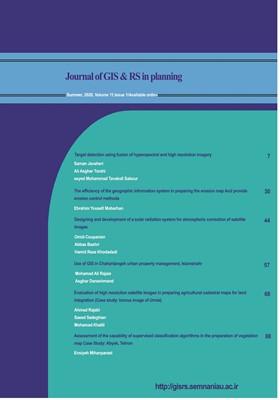Designing and development of a solar radiation system for atmospheric correction of satellite images
Subject Areas : Environmental planningحسن حسنی مقدم 1 , Omid Coupanian 2 , Abbas Bashri 3 , Hamid Reza Khodadadi 4
1 - کارشناس ارشد سنجش از دور و GIS، دانشگاه خوارزمی تهران
2 - MSc of Physics, Faculty of information and communication technology, Imam Hosein University
3 - Instructor of Electronic, , Faculty of information and communication technology, Imam Hosein University
4 - Assistant professor of electronic, Faculty of information and communication technology, Imam Hosein University
Keywords: Solar radiation, Satellite Images, Atmospheric correction, Laboratory calibration, Aerosol optical depth,
Abstract :
Applying atmospheric corrections in order to reduce the attenuation effects of the atmosphere on the quality and accuracy of the recorded data, requires a comprehensive knowledge of the conditions, characteristics, and behavior of the atmosphere as the sensor passes through the target coordinates. Nowadays, many equipment's, models and algorithms are used to study the components of the atmosphere. For this reason, in this research, a native solar radiation system was designed and built to calculate the optical depth of air aerosol. In order to simulate and investigate the effects of changes in each atmospheric component, the MODTRAN model was used in PCModWin environment. In this electro-optical system, at two wavelengths of 450 and 550 nm, due to the absorption range of the air aerosol, in two different days in terms of the amount of pollutants in the atmosphere, intense data were recorded. In order to ensure the uniformity and linearity of the response of the designed electro-optical system to measure changes in the intensity of sunlight, radiometric calibration of this system was performed. Using atmospheric models, from the recorded intensity data, the optical depth of the weather and the horizontal atmospheric metrics were calculated. In order to verify and evaluate the performance of the designed system, optical depth data obtained from MODIS (Aqua) sensor and horizontal exponential data of Mehrabad Airport meteorological station were used. The results of the accuracy evaluation showed that the calculation of the optical depth by the system designed and the MODIS sensor (Aqua) both shows a number of 0.5 in the passing hour of the satellite. The results also show a good correlation between the horizontal visibility calculated in this study and the data obtained from the reference meteorological station.
_||_


